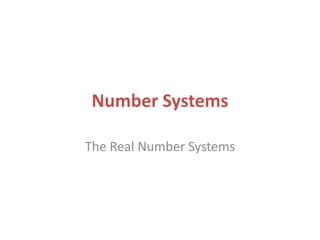
The real number system
- 1. Number Systems The Real Number Systems
- 2. Objectives: • To determine what qualifies something as a mathematical object. • To develop some of the basic properties of numbers and number systems
- 3. Are phone numbers considered mathematical objects?
- 4. Number System • A set of objects used together with operations that satisfy some predetermined properties. Objects: 0, 1, 2, -4, 0.6, ⅔, IV Operations: +, - , , ÷ Properties: = , > , < , ≠
- 5. Before we invented calculators and electricity, how did the earliest cultures use math?
- 7. Natural Numbers Are also called the counting numbers because they are the numbers we use to count with. N: 1, 2, 3, 4, 5,… These numbers were originally used the keep track of the number of animals, as rankings (1st place, 2nd place, 3rd place, etc.), or creating calendars. What kinds of numbers are missing from this set?
- 8. Whole Numbers This set of numbers is the same as the set of natural (counting) numbers except for the symbol to represent nothing (0). W: 0, 1, 2, 3, 4, 5… Besides representing nothing, what other important role does the symbol 0 have in our current number system?
- 9. Limitations of Natural and Whole #s 1) If we add together any two whole numbers, is the result always a whole number? 2) If we subtract any two whole numbers, is the result always a whole number? 3) If we multiply any two whole numbers, is the result always a whole number? 4) If we divide any two whole numbers, is the result always a whole number?
- 10. Integers This set of numbers includes the set of whole numbers and the negative integers, which are values below zero. Z: … -3, -2, -1, 0, 1, 2, 3,… Why do you think we need negative numbers? Where do we see them in our daily lives?
- 11. Limitations of the Integers 1) If we add together any two integers, is the result always a integer? 2) If we subtract any two integers, is the result always a integer? 3) If we multiply any two integers, is the result always a integer? 4) If we divide any two integers, is the result always a integers?
- 12. … - 3, - 2, - 1 0 1, 2, 3… Integers Natural Numbers Whole Numbers
- 13. Use a calculator to evaluate each of the fractions below. Write down the first 6 decimal places. If it appears to be a repeating decimal write it with the bar symbol (i.e. )
- 14. Fractions are written in the form where a is called the numerator and b is called the denominator. The denominator tells us how many equal parts the whole is broken into and the numerator tells us how many parts we have.
- 15. Collins Writing (Type I -1 point): Most algebra textbooks define rational numbers as the quotient of two integers. Using your knowledge of rational numbers and these terms, to write a definition for rational numbers in your own words.
- 16. All rational numbers can be written as a fraction or a decimal. However, only repeating or terminating (ending) decimals can be written as a fraction (i.e. as a rational number). We will learn about decimals that do not have these characteristics in the next section.
- 17. Irrational numberscannot be written as a fraction. This set of numbers include non- repeating and non-terminating decimals.
Editor's Notes
- Answer: No. Phone numbers are considered numbers, but it doesn’t make sense to perform any mathematical operations on these numbers like adding or taking an average. Have the students list some other numbers that wouldn’t be consider mathematical objects (SS #, zip code, credit card #)
- Answer: Counting, keeping track of the number of animals in a heard or other belongings. Before there were number systems, early sheppard’s actually used stones and two buckets to keep track of their sheep. When they migrated in the morning they would fill up one buck with one stone for each sheep. Then when they returned in the evening, they would move the one stone from the full bucket to the empty bucket for each sheep to make sure none of the sheep went missing.
- We use the Hindu-Arabic symbols today is because they were developed in India, where most of the world’s, including European countries, visited for trading goods and money.
- We don’t start counting with zero, which was not introduced as a symbol for almost 2000 years after the first number set. The natural numbers are also missing negative numbers.
- Answer: Zero is also a place holder in our number system. It allows us to see the difference between 21 and 201 and 210.
- Answers: 1) Yes. 2) No. 2 – 3 = -1 3) Yes. 4) No. 2 / 3 = 0.6 repeating
- The first place in history we saw the concept of negative numbers was in China and India to maintain trading accounts (300 B.C.).They used red numbers to represent positives, and black for negative (which is opposite of what we use in America today). Until recent history many culture tried to avoid using negative numbers explicitly. The history books tell us that Julius Caesar was born in 100 B.C., not –100. The subterranean levels in a parking garage often have names like B1 and B2. Temperatures are one of the few exceptions where we actually use the negative symbol. (Note: They use the letter Z instead of I because the use I for irrational numbers. Not clear where the Z comes from).
- Answers: 1) Yes. 2) Yes. 3) Yes. 4) No. 2 / 3 = 0.6 repeating
- The Natural numbers are considered a subset of the Whole numbers, and the Whole numbers are a subset of the set of Integers.
